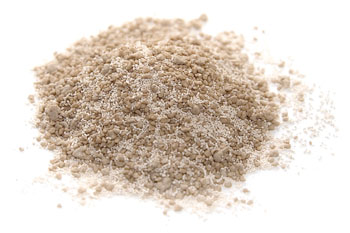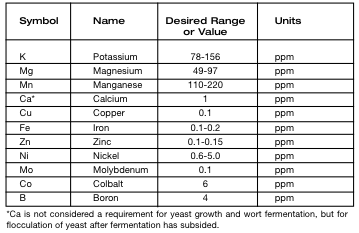Using Yeast Nutrients
Proper nutrition of brewing yeast is critical for yeast to grow unimpeded and ferment our wort without limitation to produce all the flavors and byproducts we desire in our beer. Adding supplemental yeast nutrient to every batch of wort is cheap insurance against a stuck, incomplete or otherwise substandard fermentation. For some styles of beer, supplemental yeast nutrients may be critical to a successful fermentation if nutrients in the wort are lacking due to a higher proportion of non-malt adjuncts in the recipe. Variations in the mineral content of potable water across the country and the fact that some brewers must use reverse osmosis or distilled water for brewing may also necessitate the addition of yeast nutrients to each batch of wort. Knowing how to choose and use yeast nutrients can help you make consistently superior beer by assuring your yeast are well fed every time.
What yeast needs
To grow, reproduce and ferment our beer, yeast require a source of energy (sugar), water, oxygen (sterol production for healthy membranes), phosphorus (for DNA replication and energy transfer), sulfur (to build amino acids), amino acids (or nitrogen with which to build amino acids that are used to manufacture protein and enzymes), fatty acids (a building block of cell membranes), potassium, magnesium, manganese, copper, iron, zinc, nickel, molybdenum, cobalt, boron, biotin (vitamin B7), nicotinic acid (Niacin or vitamin B3), and pantothenic acid (vitamin B5). The B vitamins are necessary for most enzymatic reactions that build protein, fatty acids, carbohydrates and DNA. The other mineral elements are involved mostly in enzymatic reactions.
Some or all of these essentials in the life of yeast are present in barley malt and/or the water used in brewing. However, not all of what yeast need are always present in adequate amounts for them to reach their full potential of growth, reproduction and metabolism necessary to make great beer. If you are brewing an all-malt beer using tap water, you may not need much, if any, additional yeast nutrient depending on the chemistry of your tap water. If you are brewing a beer with 25% or more non-malt adjuncts and/or using distilled or reverse osmosis water, your wort may be lacking some of the essential constituents for brewing fungi to perform their work successfully.
Most of the time, wort will be adequately nutritious to the yeast. If it is deficient, however, it is most likely a lack of nitrogen, phosphorus, zinc and biotin. Yeast needs nitrogen and phosphorus in significant quantities that may not be in adequate supply in wort, particularly for beers at each end of the original gravity spectrum. Both lighter and heavy styles of beer may rely on non-malt adjuncts; the former to keep the color light and the latter to boost alcohol or manage color and/or flavor. Either way, refined sugars or other non-malt adjuncts do not contain many of the things yeast need, but this is not typical. Zinc and biotin are two things that tend to be deficient in both barley malt and brewing water. Therefore, some supplementation of nitrogen, phosphorus, zinc and biotin is helpful in most situations to achieve top yeast performance.
Nutrient rundown
Yeast nutrients basically come in four types: diammonium phosphate, yeast hulls, yeast nutrient or energizer, such as Wyeast’s Brewer’s Choice Nutrient Blend and most recently, special dried yeast product called Servomyces from White Labs. If a brewer has any concerns, a dose of Servomyces, or some other complete yeast nutrient, is all that’s needed.
Diammonium phosphate, or DAP, (a commonly used plant fertilizer) supplies nitrogen and phosphorus to yeast, but nothing else. Therefore, DAP is useful as a basic yeast nutrient to supply nitrogen and phosphorus, but will not help rectify a deficiency of any other essential mineral or compound. DAP can be added to the wort during the boil, or added to the boil of a yeast starter wort. A half teaspoon of DAP is generally recommended for addition to a 5-gallon (19-L) batch of wort. Barely a pinch is all that should be added to starter wort of a gallon (3.8L) or less in size if it is needed.
Yeast hulls are the dried bodies of yeast themselves. If the yeast was grown in a medium that supplied all of the essentials for their growth, then some proportionate amount of those essentials will be retained in the yeast after they are dried and killed. Yeast hulls have a limited content of nitrogen and phosphorus and therefore may need to be supplemented with DAP in a very light or high adjunct beer recipe. As a general rule, a teaspoon of yeast hulls is recommended in a 5-gallon (19-L) batch of wort, less for a smaller volume of starter wort.
Yeast hulls are often combined with DAP and other ingredients and sold as yeast “nutrient,” “energizer” or “fermentation aid.” If you want to be sure that a yeast nutrient contains zinc, biotin or other particular compounds, check the information on the supplier’s website or catalog for a detailed description of the product. A teaspoon of yeast “nutrient” or “energizer” should be sufficient for a 5-gallon (19-L) batch of wort, with proportionately less used in a smaller volume of starter wort.
Servomyces is a unique yeast nutrient product comprised of dried and killed yeast that were grown under special conditions in a nutrient medium fortified with zinc and magnesium. With an ample supply of essential elements and compounds contained in the cell walls of the dried and killed Servomyces, the cargo of goods for the yeast that will ferment wort is more bio-available and less likely to become chelated (tied to large organic molecules) in the wort. Therefore, Servomyces not only provides a proper mix of essential compounds for yeast nutrition, but provides them in a form that is easily assimilated by the active yeast we pitch into the wort to conduct fermentation. Servomyces was developed for the commercial brewing industry, but is now available in small capsules for use by homebrewers. One capsule is sufficient to treat a 5-gallon (19-L) batch of wort with proportionately less used in a smaller volume of starter wort. It is recommended that Servomyces be added to wort during the last ten minutes of the boil.
There are also other alternatives to commercially available yeast nutrient preparations that you may already have around the house. Since zinc and biotin are the most commonly deficient yeast nutrients in typical wort, I took a look at the zinc supplement and B-complex vitamins I have been taking each day for my own health and well-being. The label on the zinc supplement showed that each tablet contains 15 mg of zinc as zinc gluconate. One quarter of a tablet of this supplement would provide approximately 0.2 ppm in a 5-gallon (19-L) batch of wort; close to the recommended amount suggested for proper yeast nutrition. I also checked the label on my B-complex supplement and found that it contains vitamins B3, B5 and B7; all the B vitamins recommended for proper yeast nutrition. As with the zinc supplement, a quarter of a B-complex tablet should be sufficient in a 5-gallon (19-L) batch of wort. Each of these nutritional supplements could easily be ground into powder and added to the boiling wort to supply zinc and B-vitamins to the chosen yeast.
Other alternative sources of yeast nutrient might be: brewing yeast that is past the recommended viability date, yeast used for baking or brewers yeast sold as a human nutritional supplement. Any of these products are a form of yeast that includes the good things that actively growing yeast would need in one form or another. If added to the boil, the yeast would be killed so as not to compete with the desired strain of yeast pitched for fermentation. Any of these products with the addition of some zinc, B-vitamin complex and DAP (in the amounts recommended previously) would result in a fairly good homemade yeast nutrient blend. Remember, a little goes a long way.
Trace elements
Many trace elements that yeast need are typically present in barley malt and/or tap water used for brewing. Most of these trace elements are used by yeast for enzymatic reactions or metabolism. The table on page 57 shows the desired range or value for essential trace elements in wort to meet the nutritional requirements of yeast. Other than potassium, magnesium and manganese, most elements are needed in very small amounts and are available in tap water or from metal utensils or containers used in the brewing process.
If you have a detailed analysis of your private water supply, you can check it against the table to see if any essential yeast minerals are lacking. Municipal water suppliers will usually be happy to provide you with a copy of the finished water analysis.
Water
If you are concerned that your brewing water may be short of a particular essential element such as; phosphorus, potassium, magnesium, manganese, or zinc, check your local health food store for a nutritional supplement containing that particular element. Review the product label for the amount of the element present in each tablet. The amount of element available is usually expressed in milligrams (mg) per serving. Divide the amount of available element in mg by the number of liters in your brewing batch size and you will have the mg/L or parts per million (ppm) increase of that element in your wort. For example; if your brewing water is low in Magnesium and you have a nutritional supplement that contains 400 mg of Magnesium per tablet added to a 5-gallon (19-L) batch of wort, that tablet would increase the Magnesium concentration by 21 ppm (400 mg/19 L = 21 mg/L or 21 ppm). Be aware that a “serving” may be more than one tablet or capsule.





